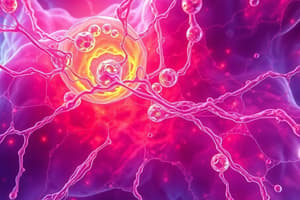Podcast
Questions and Answers
Which level of tissue organization is characterized by cells being composed of various molecules?
Which level of tissue organization is characterized by cells being composed of various molecules?
- Tissue level
- System level
- Chemical level
- Cellular level (correct)
What role does the extracellular matrix play in tissue functionality?
What role does the extracellular matrix play in tissue functionality?
- It serves as the primary site for cellular respiration.
- It solely composes blood vessels in tissues.
- It provides energy for cell metabolism.
- It influences the structure and function of the tissue type. (correct)
Which molecule in the extracellular matrix is primarily responsible for providing strength and structure?
Which molecule in the extracellular matrix is primarily responsible for providing strength and structure?
- Proteoglycans
- Elastin
- Collagen (correct)
- Integrins
What property does elastin contribute to the extracellular matrix?
What property does elastin contribute to the extracellular matrix?
Which type of tissue includes nerve cells that provide sensation?
Which type of tissue includes nerve cells that provide sensation?
Which component of the extracellular matrix is essential for attracting water and contributes to the softness of tissues?
Which component of the extracellular matrix is essential for attracting water and contributes to the softness of tissues?
What type of connective tissue mainly fills spaces and provides structural support in the skin?
What type of connective tissue mainly fills spaces and provides structural support in the skin?
Which characteristic best describes integrins in the context of the extracellular matrix?
Which characteristic best describes integrins in the context of the extracellular matrix?
Which of the following accurately describes immature bone?
Which of the following accurately describes immature bone?
What is a characteristic of mature bone?
What is a characteristic of mature bone?
During which process does woven bone remodel into mature bone?
During which process does woven bone remodel into mature bone?
Which factor does NOT influence the duration of fracture healing?
Which factor does NOT influence the duration of fracture healing?
Which of the following cell types is NOT involved in the initial phase of fracture repair?
Which of the following cell types is NOT involved in the initial phase of fracture repair?
What role do Haversian canals play in mature bone?
What role do Haversian canals play in mature bone?
During which stage of fracture healing does the hematoma form?
During which stage of fracture healing does the hematoma form?
Which of the following is true regarding neovascularization in fracture healing?
Which of the following is true regarding neovascularization in fracture healing?
What characterizes transudate fluid?
What characterizes transudate fluid?
What is the major goal of vascular alterations during inflammation?
What is the major goal of vascular alterations during inflammation?
What condition can lead to decreased fluid reabsorption due to increased venous resistance?
What condition can lead to decreased fluid reabsorption due to increased venous resistance?
Which of the following is an example of a condition that slows or stops lymphatic flow?
Which of the following is an example of a condition that slows or stops lymphatic flow?
Which of the following best describes the process of diapedesis?
Which of the following best describes the process of diapedesis?
During inflammation, what effect does vasodilation initially have on blood flow?
During inflammation, what effect does vasodilation initially have on blood flow?
What differentiates pitting edema from non-pitting edema?
What differentiates pitting edema from non-pitting edema?
Why do veins have greater distensibility compared to arteries?
Why do veins have greater distensibility compared to arteries?
What is the role of chemotaxis in the inflammatory response?
What is the role of chemotaxis in the inflammatory response?
What is the primary mechanism responsible for the formation of pitting edema?
What is the primary mechanism responsible for the formation of pitting edema?
How do lymphatic vessels contribute to the inflammatory response?
How do lymphatic vessels contribute to the inflammatory response?
What is the process of margination in the context of inflammation?
What is the process of margination in the context of inflammation?
What is the primary role of veins in the circulatory system?
What is the primary role of veins in the circulatory system?
What is a key function of leukocytes during inflammation?
What is a key function of leukocytes during inflammation?
What does the relationship between volume and pressure in the arterial system indicate?
What does the relationship between volume and pressure in the arterial system indicate?
Which of the following best explains why edema occurs?
Which of the following best explains why edema occurs?
What is the main effect of small changes in blood volume on arterial pressure?
What is the main effect of small changes in blood volume on arterial pressure?
How do large changes in blood volume affect venous pressure?
How do large changes in blood volume affect venous pressure?
What role does aortic distensibility play during cardiac diastole?
What role does aortic distensibility play during cardiac diastole?
What defines pulse pressure?
What defines pulse pressure?
What does a high pulse pressure indicate clinically?
What does a high pulse pressure indicate clinically?
What is typically the cause of a low pulse pressure, referred to as a 'thready' pulse?
What is typically the cause of a low pulse pressure, referred to as a 'thready' pulse?
Which of the following scenarios would contribute to a high pulse pressure?
Which of the following scenarios would contribute to a high pulse pressure?
During systole, what happens to the aorta?
During systole, what happens to the aorta?
Flashcards are hidden until you start studying
Study Notes
Tissue Organization Hierarchy
- Chemical Level: Atoms combine to form molecules.
- Cellular Level: Cells are composed of various molecules.
- Tissue Level: Tissues are composed of cells and the extracellular matrix (ECM) they produce.
- System Level: Systems are formed by different tissues types working together.
- For example, the skin system includes the epidermis (epithelial tissue), dermis (connective tissue), blood vessels (epithelial and connective tissue), and nerves (nervous tissue).
Extracellular Matrix (ECM)
- ECM is comprised of fluids and molecules secreted by cells.
- The ECM influences the structure and function of the tissue.
- For example, the ECM of bone cells makes bone rigid, while the ECM of tendon cells makes tendons stretchy.
Major ECM Molecules
- Collagen: Provides structure and strength, has a triple helix structure.
- Elastin: Provides elasticity (stretchiness).
- Proteoglycans: Fill space and attract water, influencing tissue softness.
- Cartilage has numerous proteoglycans, providing cushioning.
- Integrins: Act as "glue" connecting cells to each other and to other ECM components.
Bone Tissue Types
- Immature Bone (Woven Bone):
- Also known as "primary bone".
- Found during fracture repair and fetal growth.
- Weaker than mature bone due to irregular collagen structure and less mineral content.
- Mature Bone (Lamellar Bone):
- Also known as "secondary bone".
- Forms during remodeling of woven bone.
- Stronger than woven bone.
- Osteon structure: Concentric rings adapted to stressors, with osteocytes housed in lacunae.
- Haversian canals: Contain blood vessels and lymphatics.
- Volkmann's canals: Connect osteons together.
- More mineral content in osteoid than woven bone.
Fracture Repair
- Healing occurs through regeneration and remodeling, aiming for scar-free restoration and optimal function.
- Duration depends on factors like fracture site, type, treatment, soft tissue involvement, and individual factors such as age, immune status, and nutrition.
- Phases of healing:
- Internal bleeding: Cells (fibroblasts, platelets, osteoprogenitor cells, mesenchymal cells, inflammatory cells) are delivered to the site, secreting growth factors.
- Hematoma formation: Lasts about a week.
- Inflammation: Granulation tissue (fibrosis and neovascularization) forms.
Vascular Alterations in Inflammation
- Goal of vascular alterations is to increase movement of plasma proteins and cells from the blood to the injury site ("exudation").
- Increased capillary permeability: Inter-endothelial spaces widen, allowing fluid and protein leakage.
- Vasodilation: Increased blood flow to the injured area initially.
- Decreased blood flow: After fluid leakage, increased blood viscosity occurs, leading to reduced flow.
- Fluid clotting: Increased fibrinogen leads to clotting.
- Leukocyte migration and accumulation: They destroy pathogens, release toxins, clean up debris through phagocytosis, and release growth factors for healing.
Leukocyte Role in Inflammation
- Removal of injurious stimulus: Destroy pathogens and remove debris.
- Release of toxic substances: Inactivate and degrade pathogens.
- Phagocytosis: Clean up the area of debris.
- Growth factor release: Promote healing and regeneration.
Leukocyte Movement in Inflammation
- Stasis: Engorgement of blood vessels slows blood flow.
- Margination: Leukocytes accumulate along the endothelial cells of blood vessel walls due to adhesion molecules.
- Diapedesis: Leukocytes actively migrate out of the blood vessel, squeezing between endothelial cells, to reach the interstitial space.
- Chemotaxis: Chemotactic agents (chemokines) attract leukocytes to the injury site.
Role of the Lymphatic System
- Drainage of exudate: Lymphatic vessels remove fluid from the interstitium, reducing edema, removing inflammatory stimuli, and removing leukocytes.
- Antigen presentation: Phagocytes present antigens to lymphocytes in lymph nodes, stimulating immune responses.
Edema
- Edema: Fluid accumulation in interstitial spaces.
- Pitting edema: Excess fluid accumulates, disrupting the gel-like consistency of the interstitial space, forming "puddles". Pressing on pitting edema leaves an indentation after finger removal.
Arterial and Venous Distensibility
- Arteries and arterioles: Thicker smooth muscle layers compared to veins.
- Veins and venules: Thinner walls, resulting in greater distensibility than arteries.
- Veins can expand more for a given blood pressure, serving as blood reservoirs.
Volume and Pressure Relationship
- Arteries: Small changes in volume cause major changes in arterial pressure due to lower distensibility.
- Veins: Large changes in volume cause small changes in venous pressure due to higher distensibility.
Aortic Distensibility and Systemic Circulation
- Systole: Blood fills the aorta and causes distension.
- Diastole: Aorta recoils, applying inward pressure against the blood, driving flow to areas of lower pressure and ensuring continuous blood flow during cardiac relaxation.
Pulse Pressure
- Definition: Difference between systolic and diastolic arterial blood pressure.
- "Bounding" pulse: High pulse pressure, potentially indicating high systolic pressure, elevated systolic and diastolic pressure (hypertension), or normal systolic pressure with low diastolic pressure.
- "Thready" pulse: Low pulse pressure, most likely caused by low systolic pressure.
Studying That Suits You
Use AI to generate personalized quizzes and flashcards to suit your learning preferences.





